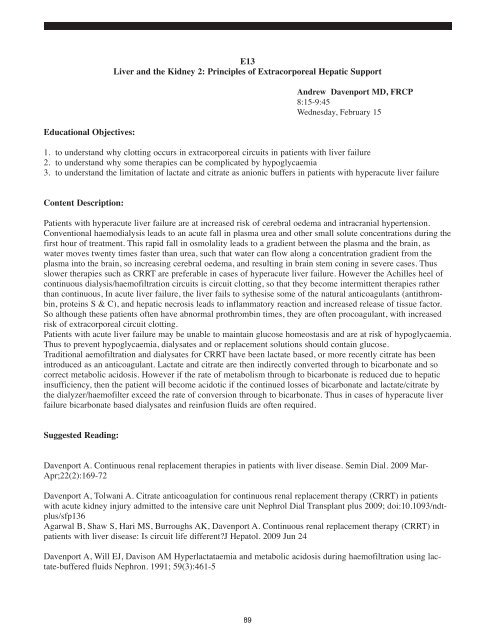ABSTRACTS from 16th International COnference on ... - CRRT Online
ABSTRACTS from 16th International COnference on ... - CRRT Online
ABSTRACTS from 16th International COnference on ... - CRRT Online
Create successful ePaper yourself
Turn your PDF publications into a flip-book with our unique Google optimized e-Paper software.
Educati<strong>on</strong>al Objectives:<br />
E13<br />
Liver and the Kidney 2: Principles of Extracorporeal Hepatic Support<br />
Andrew Davenport MD, FRCP<br />
8:15-9:45<br />
Wednesday, February 15<br />
1. to understand why clotting occurs in extracorporeal circuits in patients with liver failure<br />
2. to understand why some therapies can be complicated by hypoglycaemia<br />
3. to understand the limitati<strong>on</strong> of lactate and citrate as ani<strong>on</strong>ic buffers in patients with hyperacute liver failure<br />
C<strong>on</strong>tent Descripti<strong>on</strong>:<br />
Patients with hyperacute liver failure are at increased risk of cerebral oedema and intracranial hypertensi<strong>on</strong>.<br />
C<strong>on</strong>venti<strong>on</strong>al haemodialysis leads to an acute fall in plasma urea and other small solute c<strong>on</strong>centrati<strong>on</strong>s during the<br />
first hour of treatment. This rapid fall in osmolality leads to a gradient between the plasma and the brain, as<br />
water moves twenty times faster than urea, such that water can flow al<strong>on</strong>g a c<strong>on</strong>centrati<strong>on</strong> gradient <str<strong>on</strong>g>from</str<strong>on</strong>g> the<br />
plasma into the brain, so increasing cerebral oedema, and resulting in brain stem c<strong>on</strong>ing in severe cases. Thus<br />
slower therapies such as <strong>CRRT</strong> are preferable in cases of hyperacute liver failure. However the Achilles heel of<br />
c<strong>on</strong>tinuous dialysis/haemofiltrati<strong>on</strong> circuits is circuit clotting, so that they become intermittent therapies rather<br />
than c<strong>on</strong>tinuous, In acute liver failure, the liver fails to sythesise some of the natural anticoagulants (antithrombin,<br />
proteins S & C), and hepatic necrosis leads to inflammatory reacti<strong>on</strong> and increased release of tissue factor.<br />
So although these patients often have abnormal prothrombin times, they are often procoagulant, with increased<br />
risk of extracorporeal circuit clotting.<br />
Patients with acute liver failure may be unable to maintain glucose homeostasis and are at risk of hypoglycaemia.<br />
Thus to prevent hypoglycaemia, dialysates and or replacement soluti<strong>on</strong>s should c<strong>on</strong>tain glucose.<br />
Traditi<strong>on</strong>al aemofiltrati<strong>on</strong> and dialysates for <strong>CRRT</strong> have been lactate based, or more recently citrate has been<br />
introduced as an anticoagulant. Lactate and citrate are then indirectly c<strong>on</strong>verted through to bicarb<strong>on</strong>ate and so<br />
correct metabolic acidosis. However if the rate of metabolism through to bicarb<strong>on</strong>ate is reduced due to hepatic<br />
insufficiency, then the patient will become acidotic if the c<strong>on</strong>tinued losses of bicarb<strong>on</strong>ate and lactate/citrate by<br />
the dialyzer/haemofilter exceed the rate of c<strong>on</strong>versi<strong>on</strong> through to bicarb<strong>on</strong>ate. Thus in cases of hyperacute liver<br />
failure bicarb<strong>on</strong>ate based dialysates and reinfusi<strong>on</strong> fluids are often required.<br />
Suggested Reading:<br />
Davenport A. C<strong>on</strong>tinuous renal replacement therapies in patients with liver disease. Semin Dial. 2009 Mar-<br />
Apr;22(2):169-72<br />
Davenport A, Tolwani A. Citrate anticoagulati<strong>on</strong> for c<strong>on</strong>tinuous renal replacement therapy (<strong>CRRT</strong>) in patients<br />
with acute kidney injury admitted to the intensive care unit Nephrol Dial Transplant plus 2009; doi:10.1093/ndtplus/sfp136<br />
Agarwal B, Shaw S, Hari MS, Burroughs AK, Davenport A. C<strong>on</strong>tinuous renal replacement therapy (<strong>CRRT</strong>) in<br />
patients with liver disease: Is circuit life different?J Hepatol. 2009 Jun 24<br />
Davenport A, Will EJ, Davis<strong>on</strong> AM Hyperlactataemia and metabolic acidosis during haemofiltrati<strong>on</strong> using lactate-buffered<br />
fluids Nephr<strong>on</strong>. 1991; 59(3):461-5<br />
89
















